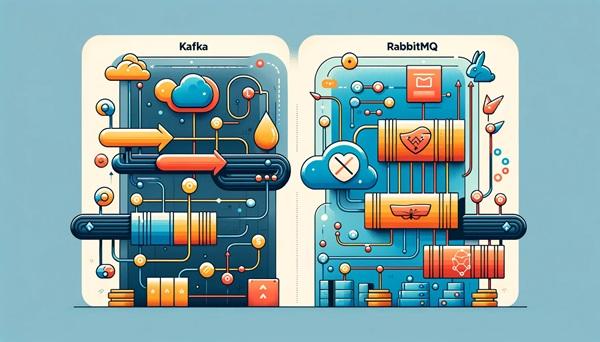What is Kafka?
Apache Kafka is a powerful open-source streaming platform for transferring data between systems and applications in real time. It is a distributed event streaming platform designed for high scalability, fault tolerance, and low-latency data processing.
Kafka allows organizations to efficiently handle and transmit data streams, making it invaluable for use cases like real-time analytics, log aggregation, monitoring, and event-driven architectures. With its ability to manage massive data volumes, Apache Kafka has become an essential tool for businesses seeking to process real-time data and build event-driven applications in today’s digital landscape.

What does Kafka do?
Real-time data streaming
High scalability
Fault tolerance
Low-latency data processing
Log aggregation
Event-driven architectures
Real-time analytics
Monitoring and alerting
Distributed and open-source
Efficient data transmission
Why do businesses use Kafka?
More and more businesses in various industries are turning to the Kafka platform because of its scalability and fault tolerance, as well as its capacity to handle data streams, support event-driven architectures, and reliably manage and process real-time data.
Real-time data processing
Kafka enables businesses to process data in real-time, making it valuable for applications that demand quick responses to changing conditions or events.
Scalability
Kafka’s architecture can horizontally scale to handle the growing data volume of modern businesses while maintaining optimal performance.
Data integration
Kafka functions as a central hub for data integration, streamlining the flow of information between different systems and applications within an organization.
Fault tolerance
Kafka’s built-in fault tolerance mechanisms ensure that data remains available and reliable even during hardware or network failures.
Log aggregation
Kafka simplifies log aggregation by consolidating logs from various sources, easing log management, analysis, and troubleshooting.
Event-driven architectures
Kafka’s event-driven architectures support the building of responsive, event-triggered applications that react to changes in real-time.
Real-time analytics
With Kafka, businesses can access real-time data analytics and derive valuable insights from data streams as they flow through the platform.
Monitoring and alerting
Kafka provides robust monitoring and alerting capabilities, helping organizations maintain the health and performance of their data pipelines.
Data durability
Kafka ensures data durability through data retention and replication options, minimizing the risk of data loss.
Open source
Kafka being open source helps businesses to save on licensing costs while benefiting from an active community that continuously enhances the platform.
Efficiency
Kafka efficiently transmits data across systems, reducing latency and ensuring data consistency throughout the organization.
How does Kafka work?
Apache Kafka operates as a distributed event streaming platform, simplifying real-time collection, storage, and processing of data streams. Its core structure revolves around a publish-subscribe model, with producers publishing data and consumers consuming it. Data is organized into topics, which serve as channels or categories, with each topic further divided into partitions. This allows Kafka to distribute and parallelize data processing across multiple servers and consumers. Kafka brokers, which are servers responsible for storing and managing data, receive records from producers, store them in topic partitions, and serve them to consumers. While Kafka initially relied on ZooKeeper for cluster coordination, newer versions have been moving away from this dependency.
The role of producers involves publishing data records to specific topics, allowing consumers to subscribe to topics of interest. Kafka Connect can add declarative data integration to connect data syncs and data sources to Kafka. Consumers, on the other hand, retrieve and process data records from Kafka. Kafka offers both consumer groups, enabling load balancing among multiple and single consumers, providing low-level control over data processing. Kafka uses data retention and log compaction mechanisms to store data for a set time and minimize storage by keeping the most recent value for each key in a topic. Kafka’s design emphasizes scalability, fault tolerance, and data reliability, making it a robust choice for handling data streams in various real-time use cases.
Who should use Kafka?
Kafka is a valuable tool for any organization that needs to handle large volumes of real-time data, build responsive applications, centralize data, and ensure efficient and reliable data flow across their ecosystem. It is particularly well-suited for:
Big data and real-time analytics
Companies dealing with large volumes of data that require real-time analysis, such as e-commerce platforms, financial institutions, and social media companies, can leverage Kafka to process and analyze data as it is generated.
Event-driven architectures
Organizations looking to build event-driven applications that address real-time events, triggers, or changes in data can use Kafka as a service to create responsive and efficient systems.
Log and event data management
Kafka is a top choice for centralizing log and event data from various sources and simplifying log management, analysis, and troubleshooting.
IoT (Internet of Things)
Kafka is a valuable tool for businesses in the IoT industry, where numerous devices generate data. It allows them to ingest, process, and analyze sensor data in real-time.
Microservices communication
In microservices architectures, Kafka can act as a communication backbone, enabling various microservices to seamlessly exchange data and event logs.
Data integration
Organizations seeking to integrate and share data across multiple systems and applications can use Kafka as a service to ensure efficient, reliable, and real-time data flow.
Data pipelines and ETL (Extract, Transform, Load)
Kafka can serve as a critical component in building data pipelines for data streaming and ETL processes, enabling the transformation and loading of data into various data repositories.
Log and metric aggregation
Kafka can aggregate logs, metrics, and event data from various sources, making it easier to monitor and analyze system behavior and performance.
Highly scalable and fault-tolerant systems
Industries requiring highly scalable and fault-tolerant systems, like telecommunications, can benefit from Kafka’s robust architecture.
Message queues and pub-sub systems replacement
Kafka can replace traditional message queuing and publish-subscribe systems, offering more flexibility, scalability, and performance.
How secure is Kafka?
Apache Kafka ensures data security by offering several features and options to safeguard data and maintain the confidentiality and integrity of messages within its ecosystem. These security measures include robust authentication mechanisms such as SSL/TLS, SASL, and Kerberos, which ensure only authorized users and services can access Kafka resources. Authorization controls, implemented through role-based access control (RBAC), enable fine-grained permissions management, allowing organizations to define and apply access policies for topics and clusters.
Kafka also supports encryption, both in transit and at rest. It employs SSL/TLS to secure data while it’s being transmitted, ensuring that communication between clients and brokers remains secure. Furthermore, data encryption at rest protects stored data on disk from unauthorized access. To enhance security monitoring and compliance, Kafka offers audit logging, which records actions and access attempts, providing an audit trail for review.
What’s the difference between Apache Kafka and RabbitMQ?
Apache Kafka and RabbitMQ differ mainly in their use cases and design principles. Kafka is intended for real-time event streaming and data processing, whereas RabbitMQ is designed for reliable message queuing and communication between applications.
Apache Kafka primarily focuses on enabling fast real-time event streaming and data processing with high throughput. Its ability to handle massive data volumes makes it ideal for scenarios requiring real-time ingestion, processing, and analysis. Kafka’s architecture includes topics and partitions that allow distributed data streaming, and it ensures durability and fault tolerance through replication. Kafka is commonly used in real-time analytics, log aggregation, event sourcing, and event-driven systems.
RabbitMQ, on the other hand, is a traditional message queue system designed for message routing and reliable communication between applications or microservices. It employs messaging patterns like point-to-point and publish-subscribe, making it well-suited for workload distribution, load balancing, and task queuing. RabbitMQ offers features like message acknowledgment and re-queuing to ensure message reliability. It is typically used in scenarios that require reliable message delivery, task scheduling, and decoupling of components within a system.

What’s the difference between Apache Kafka and Apache Zookeeper?

The main differences between Apache Kafka and Apache Zookeeper lie in their primary use cases and data models. Kafka focuses on real-time data streaming and messaging, whereas ZooKeeper is designed to provide distributed coordination and maintain the consistency of distributed systems.
Apache Kafka is primarily designed for real-time event streaming, data processing, and message brokering. It excels at efficiently handling data streams, supporting publish-subscribe messaging, enabling real-time analytics and log aggregation. Kafka’s core features include topics and partitions, fault tolerance through replication, and high-throughput data ingestion, making it an essential tool for scenarios requiring data streaming and real-time insights.
In contrast, Apache ZooKeeper is a distributed coordination service that manages and synchronizes distributed applications. It plays a crucial role in maintaining the consistency and coordination of distributed systems. ZooKeeper’s use cases encompass distributed coordination, configuration management, leader election, and the maintenance of decentralized nodes in a cluster. Its data model resembles a hierarchical file system, incorporating coordination tools like locks and barriers to ensure strong consistency and high availability for distributed applications.
Apache Kafka and OVHcloud
OVHcloud offers a robust and flexible cloud infrastructure for effectively running Apache Kafka clusters efficiently. By leveraging OVHcloud’s services and resources, organizations can benefit from a reliable and scalable hosted Kafka deployment.
Deploy Kafka on VMs or servers
Install and configure Apache Kafka on the chosen VMs or servers. You can follow Kafka’s official installation instructions and guidelines to set up your Kafka brokers, ZooKeeper (if needed), and other components. Watch Kafka tutorials to learn more about using Apache Kafka in a cloud environment.
Scale Kafka clusters
OVHcloud can scale Kafka clusters vertically by adding more CPU, RAM, or storage resources to VMs, or horizontally by adding more Kafka broker instances. This scalability ensures that Kafka can handle increasing data workloads as businesses grow.
Keep your data secure
OVHcloud prioritizes data security and offers features like firewalls, private networks, and encryption to protect your Kafka clusters and the data they handle. These security measures are essential for keeping sensitive data secure.
OVHcloud and Kafka
At OVHcloud, we understand the critical role that robust data processing frameworks like Kafka play in your IT infrastructure. By harnessing our scalable and reliable cloud solutions, you can set up the necessary infrastructure for seamless data streaming and processing to serve today’s data-driven IT environments. Our commitment to an open, hybrid cloud ensures you get a flexible architecture, so you can fine-tune your Kafka deployment to match your needs, without the burden of steep costs or data migration hurdles. This is reinforced by a global network that ensures your data is securely stored and protected in a location you trust, as well as a commitment to sustainability that aligns with forward-thinking IT strategies. Unlock the full potential of your Kafka projects with OVHcloud – on a platform built for resilience, flexibility, and cost efficiency.
